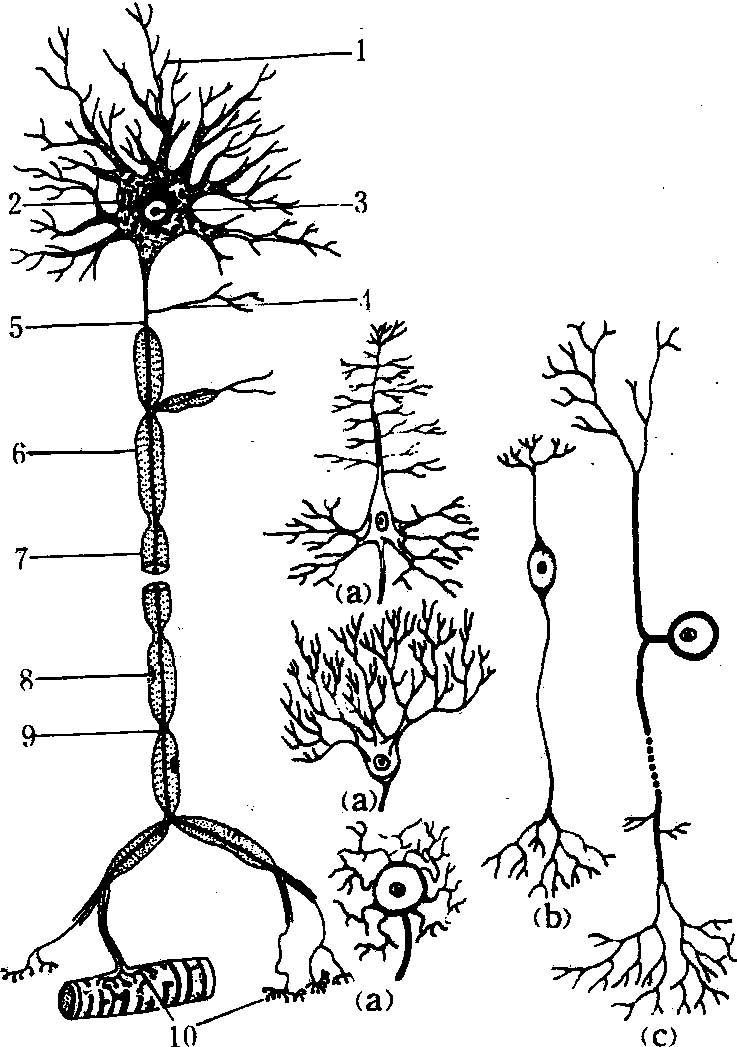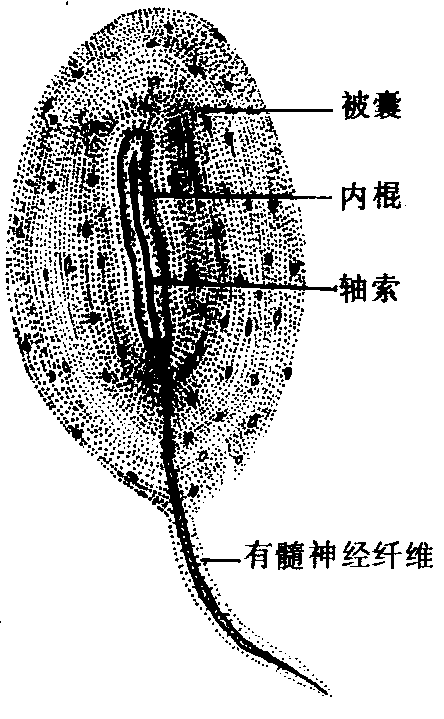神经组织shenjingzuzhi
由神经细胞和神经胶质细胞组成,是神经系统的主要成分。神经细胞又称神经元,有接受刺激,产生兴奋和传导兴奋的功能,是神经组织的主要成分。神经胶质细胞则对神经细胞具有绝缘、支持、营养、保护等作用。神经组织分布于脑、脊髓和神经中。神经则广泛分布于身体所有的器官、组织内。它可以支配和调节各器官、系统的机能活动,使人体成为一个统一的整体,从而能适应内、外环境的复杂变化。
神经组织nervous tissue
具有感受刺激和传导兴奋的神经细胞和神经胶质细胞构成的组织。神经细胞又称神经元,是神经组织的结构和功能单位。相邻两神经元之间有特殊的连接结构称突触,能将一个神经元的冲动传递给另一个神经元。神经胶质细胞位于神经元之间,对神经元起支持、保护和营养等作用。它们以特有的构筑形式构成神经系统。神经细胞和大部分神经胶质细胞来源于胚胎期的神经管和神经嵴。神经管最初为假复层柱状上皮称神经上皮,不断分裂分化神经细胞和胶质细胞,前者发育为中枢神经系的神经元,后者发育为神经元之间的神经胶质细胞。神经嵴细胞一部分分化为脑脊神经节细胞和植物性神经节细胞,另一部分则分化为神经膜细胞和卫星细胞,即周围神经系中的神经胶质细胞。
神经元 具有胞体和突起两部分,形态多样,种类很多。
胞体 大小差异很大,小的直径5~6μm,如小脑颗粒细胞,大的可达150μm,如大脑皮层的大锥体细胞。胞体的表面有细胞膜,其膜蛋白有的是离子通道,有的是受体,神经冲动的传播沿细胞膜进行。胞体中通常有一个大而圆、淡染的细胞核,核仁大而明显。核的周围胞质称核周部,除线粒体和溶酶体等细胞器外,还有神经元中特有的尼氏体和神经原纤维。前者是嗜碱性的颗粒或小块状物质,如虎皮上斑块又称虎斑,由密集排列的粗面内质网和游离核蛋白体构成,具有合成蛋白质的作用。
胞体主要位于脑和脊髓及神经节内,其长突起则离开脑和脊髓形成神经纤维,分布于各种组织和器官,纤维末端有的终止于体表或体内形成感觉神经末梢,有的则分布于肌肉或腺体,形成运动神经末梢。神经原纤维呈细丝状,嗜银性,由神经丝和微管集聚成束组成,它在胞体中交织成网,在突起中则平行排列,主要起运输神经递质和支持作用。
突起 突起有两种: 一种称树突,较粗大,呈树枝状分支: 另一种称轴突,细长呈索状。树突自胞体发出,1至多个,呈树枝状突起,内部构造与核周部相似,但细胞膜上有很多受体。有的神经元树突表面有鼓槌状或叶片状等的小芽称树突棘,它和受体都是突触部位。树突可接受感受器或其他神经元传来的冲动,并传给细胞体。轴突只有一个,其起始部呈圆锥状,称轴丘,向后逐渐变细而直,其细胞膜称轴膜,表面光滑,常有侧枝; 内部结构无尼氏体,只有神经原纤维及其他细胞器。其末梢形成像树根样的分支。轴突把胞体兴奋传给另一神经元或末梢反应器官。
神经元的分类 有2种分类方法。按突起数目可分为: ❶多极神经元。它有多个突起从胞体伸出,其中一个为轴突,其余为树突,绝大多数神经元属此;
❷双极神经元。从胞体伸出一个轴突、一个树突,见于视网膜和嗅觉器官;
❸假单极神经元。胚胎期有两个突起,后来它们基部合并成一个,但在离胞体不远处又分成两支,一支走向中枢,称中央支; 另一支走向外周器官,称外周支。由于它不是真正的单极,故有假单极神经元之称,仅见脑、脊神经节内(图1)。按功能可分为三类:❶感觉神经元。又称传入神经元,可感受内、外环境刺激并转变为神经冲动,传到脑或脊髓,假单极和某些双极神经元属之;
❷运动神经元。又称传出神经元,可把中枢发出的信息传至外周效应器官,导致肌肉收缩和腺体分泌等,它们分布于脑、脊髓和植物性神经节中,为多极神经元;
❸联络神经元又称中间神经元,位于上两种神经元之间,起联络作用。亦为多极神经元。

图 1 神经元的构造和类型
(a) 多极神经元; (b) 双极神经元; (c) 假单极神经元1. 树突; 2. 尼氏体; 3. 细胞核; 4. 侧枝; 5. 轴突;6. 髓鞘; 7. 神经膜; 8. 神经膜细胞; 9. 郎飞氏节;10. 感受器
突触 由两神经元接触处构成。依兴奋传递的性质可分为两种,一为电突触即缝管连接,只是少数,另一种是化学性突触,占突触大部分。按前,后位神经元接触的部位又有轴-树、轴-体、轴-轴、树-树、体-体等突触之分,常见者为前两种。以其亚微结构以轴-体突触为例,包括三个部分(图2)。❶突触前膨大及突触前膜(属前位神经元的轴突终末膨大及其细胞膜),膨大处含有神经递质小泡称突触小泡,大小不等(20~65nm),圆球形或米粒状,还有线粒体和微丝等;
❷突触后膜(属后位神经元的胞膜),其上有与递质相应的受体;
❸突触间隙,为前、后膜之间的间隙,宽约20~30nm。当神经冲动传至突触前膜时,电位控制的Ca2+通道开放,Ca2+进入突触,在线粒体提供的ATP和微丝参与下,突触小泡靠近突触前膜,以胞吐方式释放出递质至突触间隙中,递质与突触后膜上的受体结合,引起细胞膜去极化,而出现神经冲动的传递。

图 2 轴-体突触结构
(a) 突触低倍镜观; (b) 突触高倍镜观; (c) 突触亚微结构;(d) 突触小泡释放递质至突触间隙
神经纤维 主要由轴突和外包的神经胶质细胞(神经膜细胞或少突神经胶质细胞)构成。按髓鞘的有无分为有髓神经纤维和无髓神经纤维两种。
有髓神经纤维 轴突外包一层髓鞘和神经膜,髓鞘是神经膜细胞(即神经胶质细胞)的胞膜反复缠绕轴突而形成的多层膜结构,神经膜则是该细胞的含核和胞质部分,它们都有节段性。段间的间隙称神经纤维节(又称郎飞氏节),相邻节之间的一段神经纤维称节间段。在髓梢处神经兴奋不能传导,髓神经的传导是沿着神经纤维节呈跳跃式的传导,节间段愈长跳跃距离愈远,神经冲动的传导也愈快; 体内除嗅神经、视神经和植物性神经的节后纤维外,绝大部分外周神经纤维属此类型。中枢神经系的有髓神经纤维,其髓鞘由少突神经胶质细胞的突起包绕轴突形成,其神经纤维节较宽。
无髓神经纤维 轴突外无髓鞘包裹,只有一层神经膜细胞连续包在其外,故无神经纤维节。纤维较细,表面光滑,植物性神经的节后纤维属此类型。
神经末梢 外周神经纤维的终末部分,它终止于全身各器官和组织内,依功能分为感觉神经末梢和运动神经末梢两类。
感觉神经末梢 为感觉神经元外周支的终末部分。它和相连系的器官组织的接触点共同构成感受器。可感受体内、外各种刺激并传至中枢。依存在部位可分为外感受器和内感受器两种。前者感受冷、热和痛等外环境刺激,后者感受来自内脏的刺激。还有,本体感受器,感受骨骼肌和肌腱张力的改变以及关节运动的位置等。依感觉神经末梢形态结构,又可分为游离和有被囊的感觉神经末梢两种。前者是外周支反复分支并失去髓鞘,以裸露的分枝末梢分布于上皮组织和肌组织,司痛觉和冷热觉等; 后者是神经终末部周围包有结缔组织被囊,如环层小体(图3)。它是圆形或椭圆形结构,中央有一条棒状的内棍,其内有轴索,内棍外包有厚的被囊,由数十层胶原纤维膜及膜间的成纤维细胞构成。它主要分布于皮肤深层、被膜和内脏器官,司压觉。此外,还有分布于真皮乳头司触觉的触觉小体和分布于骨骼肌感受肌纤维舒缩的肌梭等。

图 3 环 层 小 体
运动神经末梢 为运动神经元的外周支末梢部分。它和相连系的器官组织(肌肉或腺体)的接触点构成效应器。如分布于骨骼肌的运动终板。其结构类似于神经元的突触。运动神经纤维入肌纤维而失去髓鞘,并反复分支,末端膨大,附着肌细胞膜上。其神经纤维的细胞膜构成突触前膜,膨大部有许多含乙酰胆碱(神经递质)的小泡、线粒体和微丝等; 突触后膜是肌细胞膜,它形成许多皱襞以增加受体数量,两者间的间隙为突触间隙。内脏传出神经的节后纤维分布于平滑肌、心肌和腺体上构成的效应器,结构简单,其分枝状末梢膨大呈扣结状或网状,与相应组织相接触。
神经胶质细胞 种类很多,分布在中枢神经系统中的有星形神经胶质细胞、少突神经胶质细胞、小胶质细胞和室管膜神经胶质细胞4种,分布在外周神经系统中的有神经膜细胞和卫星细胞2种。它们各具不同的形态和功能(图4)。

图 4 神经胶质细胞
(a) 原浆性星形胶质细胞; (b) 纤维性星形胶质细胞;(c) 少突胶质细胞; (d) 小胶质细胞
星形神经胶质细胞 呈星形,胞体大,核较大,圆形或椭圆形,它又有两种形态,一种突起细而长,分支少,表面光滑、胞质内有许多交织排列的胶质丝称纤维性神经胶质细胞; 另一种突起较粗短,表面有许多芽状分支,细胞质多而胶质丝少,称原浆性星形胶质细胞。前者分布于脑和脊髓的白质,后者分布于灰质。纤维性星形胶质细胞有的末端形成脚板状,附着于毛细血管壁上,有的突起则包绕于神经纤维上,故对神经元起着营养、排出代谢产物和支持作用。
少突神经胶质细胞 比星形胶质细胞小,核圆形,胞质少,突起少,分支也少,有的突起顶端成宽叶状,包绕于神经元轴突外形成髓鞘。
小胶质细胞 呈长梭形或不正形,胞体小,从胞体发出带有小棘的分支,核小,长圆形或三角形。它具有吞噬能力。是神经系统中唯一起源于中胚层的细胞。
室管膜细胞 被覆于脑室和脊髓中央管表面,为单层柱状细胞。有的表面有微绒毛,有的有纤毛,有的基底面有一条细长的突起,伸向深部。
神经膜细胞 又称雪旺氏细胞,包绕在轴突外面形成髓鞘和神经膜。
卫星细胞 呈扁平形,围绕在神经节细胞的周围。
神经组织
人和高等动物的基本组织之一。为神经系统的主要构成成分。由神经细胞(又称神经元)和神经胶质细胞构成。前者能接受刺激,传导冲动;后者对神经元有支持、营养、绝缘和保护等作用。
神经组织
由神经元和神经胶质细胞所组成。它们都是有突起的细胞,是构成神经系统的主要组织。神经元是神经系统的结构和功能单位,能感受刺激和传递冲动,另有一些神经元具有内分泌功能,见“神经元”。神经胶质细胞对神经元起支持、营养和保护等作用。
神经组织nervous tissue
由神经细胞和神经胶质细胞构成动物体的一种组织。是神经系统的基本结构成分。神经细胞亦称神经元,有细长突起并与其他神经元突起、感受器或效应器相连络,具感受刺激和传导冲动等功用,是实现神经系统专门功能的主要细胞。神经胶质细胞亦称神经胶质,遍布神经元间,主要起支持、保护、营养和修补神经细胞等功用。二者均起源于神经外胚层。
- harmonic motion
- harmonic progression
- harmonium
- harmony
- Harmsworth,Alfred
- Harmsworth,Harold
- Harnack,Adolf von
- harness racing
- Harnett,William Michael
- Harold Bluetooth
- Harold I Harefoot
- Harold Ⅱ
- Harold Ⅲ Hardraade
- Haroun al-Raschid
- harp
- Harpers Ferry
- Harpers Ferry Raid
- Harper,William Rainey
- Harpies
- harpoon
- harp seal
- harpsichord
- harpy eagle
- harquebus
- harrier